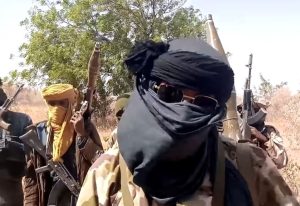
A lecturer at the Usman Danfodiyo University, Sokoto, Dr Murtala A. Rufa’I, has narrated how banditry started in Zamfara State.
Rufa’i disclosed this while presenting a paper titled, “I am a Bandit: A Decade of Research in Zamfara Bandit’s Den” at a public lecture organised by Usman Danfodiyo University.
He noted that the activities of bandit terrorists had been in place long before the arrival of colonial masters.
He said, “The hills of Kwotarkwashi and Chafe, for instance, provided shelter to the criminals, from where they organised and executed their unwholesome activities, which often resulted in serious casualties.”
“During the colonial period, the region was also confronted with a situation where bandits killed about 210 traders and made away with goods worth £165,000:00. As reported, this onslaught occurred in the Zamfara axis to victims from Kano on their way to the French territory.”
He further stated that the terrorist group resurfaced in 2011 when the first group led by Kundu and the notorious Buharin Daji both of Fulani backgrounds emerged.
“They named the group Kungiyar gayu, meaning an association of young guys, even though none of them was a youth. The public referred to them as Kungiyar Barayin Shanu, (cattle rustlers association).”
“Their real motive started to manifest itself in 2012 when cases of cattle rustling began in the state. Members of the gang considered it as a cultural association aimed at the liberation of the Fulani from the high-handedness of security agents, traditional rulers and politicians.
“This is not to justify the use of arms by the bandits against the state and innocent citizens but to unveil their deep-rooted grievances. The association was formed at a point when herders in the state were migrating to the neighbouring states, due to large scale encroachment and confiscation of the grazing areas.
“At the onset, membership was restricted to the Fulani, especially during the recruitment exercise, 2011 to 2012. Recruitment was through conscription, use of cash and cows, the promise of sex and leisure as well as intimidation of other Fulani people. Since the gang was into cattle rustling, some herders joined to circumvent cattle rustling harassment from the members.
“It was alleged that some leading Fulani families in Zamfara, Sokoto and Katsina States made donations of cash and cattle, while some expressed moral support and goodwill to the members to avoid bitter consequences.
“In the beginning gang members were mostly into rustling, robbery and other minor criminalities. The change in the pattern of operations started with the creation of Yan-Sa-Kai and the intensification of the war against members of the gangs.
“The first incident that triggered a change in the course of the conflict was the brutal killing of Alhaji Issue, in Chilin, Dan-Sadau Emirate, Maru LGA of Zamfara State. He was killed by Yan-Sa-Kai on 16th August 2012 on the accusation of harbouring criminals and supporting rustlers.
“The public murder of issue was used as a justification for reprisal and mass killings of innocent people by the gang. Furthermore, the late Issue family mobilised fighters and extended an invitation to the gang for reprisal attacks a few days later. Members of the gang multiplied in number, strength, power and weapons and even connections in 2013. It also became more heterogeneous and transnational in 2016, constituting members from the Niger Republic, Mali and Chad, mostly Tuaregs with links to Sahelian rebels,” he said.
The lecturer added that the adoption of foreign members in the group led to a transformation in their agenda.
“New members were recruited, more weapons were introduced and fighters were trained in modern guerrilla strategies and tactics. Kidnapping and abduction for ransom were adopted as a new strategy in addition to cattle rustling.
“Large numbers of poverty-stricken youth across villages were used as informants supplying intelligence for awesome pecuniary rewards,” he said.
Rufa’i noted banditry reached its peak in 2018 following the assassination of Buhari Daji while new deadly cells surfaced.
“About 30 splinter gangs emerged after the fall of Buhari Daji in the state. Buhari’s son, Aliyu Zakwai became a leader of another wing. Zakai was not as notorious as his father, but a major force to reckon with in Dansadau.
“After the introduction of amnesty by the incumbent government in Zamfara State in 2019, he accepted the programme and left the woods for a new life in the city,” he said.
This article was originally published on Naija News


